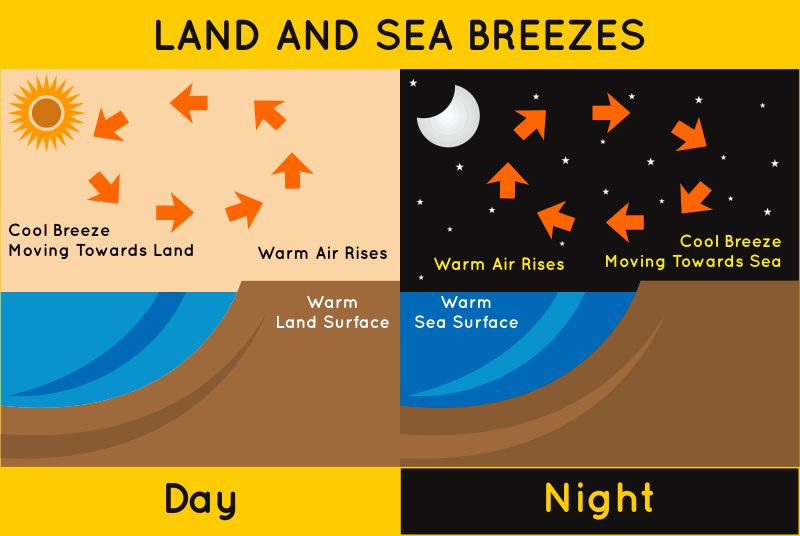Meaning of Convection of Heat
Convection is the process by which heat is transferred in a liquid or gas by the actual movement of the heated fluid from the hotter to the colder parts. Liquids and gases are poor conductors of heat but transfer heat by convection.
Using Kinetic Molecular Theory to Explain Convection in Liquids
When a liquid is heated at the bottom of its container, the molecules there expand and becomes lighter. They therefore move to the top and are then replace by denser colder molecules from the top. The new dense molecules also get heated up and become lighter and hot then move to the upper part to be replaced by others. This action set up a convection flow of heat which continues until the water boils.

Applications of Convection
1. Land and sea breeze: This is convection current in nature. It happens in coastal area.
(a) Sea breeze: In a hot day the sun warms the air near the land quickly than the sea because the earth has a lower specific heat capacity than the sea. This warm air rises. Cooler air from the sea moves to replace the risen air. This cool breeze from the sea is known as sea breeze.

Land breeze: at night, the air above the sea is hotter. There is a conventional flow of hot air from the sea rises up.They are replaced by cool air from the land. The flow of cool air from the land to the sea is called the land breeze.
- Ventilation: Air heated by respiration and fires rises towards the ventilators placed near the ceiling. This is replaced by fresh air from windows and other openings.
- Cooling of motor car engine: Car engines require cooling to prevent overheating. The heat generated by the engine is conducted by the metal to the water in the jacket. The water is cooled by the air circulating round the radiator as the vehicle moved and by the cool air from the fan
- The Domestic hot water system: Water is heated in the boiler by conduction through the metal. Hot water rises by convection to the cylinder, cold water flows in to take its place.
EVALUATION
- Describe an experiment to show Convection current in water.
Radiation, Emission and Radiation by Different Surfaces
Meaning of Radiation
Radiation is the process by which heat is transferred from a hotter to a cooler place without heating of the intervening medium. Radiation is a mode of heat transfer that does not require a material medium for its transfer. Radiation can be detected by a radiometer and a thermopile. A thermopile detects and measures radiant energy.
A black surface is a better radiator and absorber of heat than a polished/shining surface. This is why it is not advisable to wear a black cloth on a sunny day because one feels hot.
Polished surface, white surface and silvered surface are good reflectors of heat.
The Thermos Flask

This device is used to prevent loss of heat energy from its content
The three modes of heat transfer are prevented in the thermos flask in the following ways:
- The vacuum between the double walled glass prevents loss of heat by conduction and convection.
- The silver colour of the inside of the double walls prevents heat loss by radiation
- The cork support, or plastic prevents heat loss by conduction.
- The cork stopper prevents heat loss by conduction, evaporation and convection.
GENERAL EVALUATION
- Mention the features of the Thermos flask and explain how heat losses are prevented.
Read our disclaimer.
AD: Take Free online baptism course: Preachi.com 